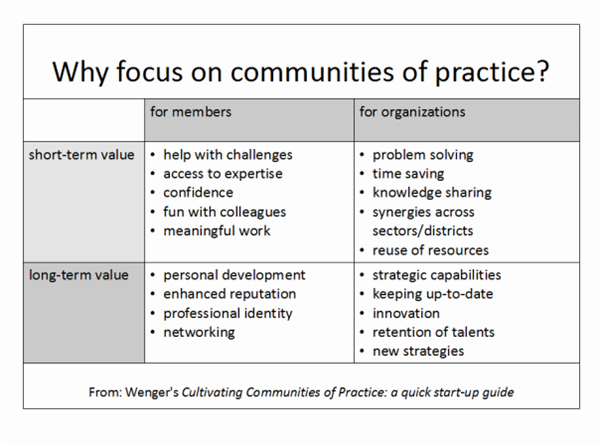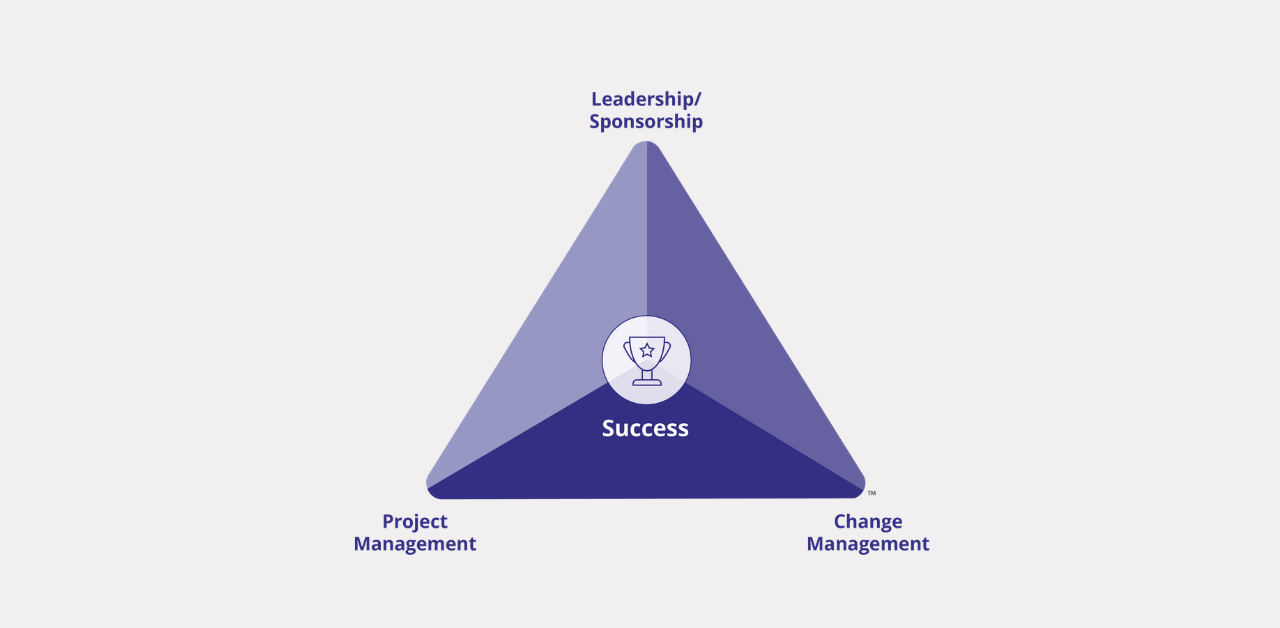So, your company has had a few Change Management Practitioners who have been certified and are actively applying a structured process and set of tools to lead the people side of change to projects. Benefits are beginning to be realised, and colleagues are now in a steady state of the new change, no longer trying to revert to the old ways of doing things.
As a Change Management Practitioner, you are now ready to move on to organisational level competency. Leadership has noticed how the application of structured change management has contributed to numerous project successes, and noticeably higher levels of adoption and usage.
Your challenge now, is to leverage that leadership support to help your organisation become more agile towards change.
The question is, how?
One of the most powerful ways is to build a Community of Practice. Etienne Wenger, education theorist and practitioner puts it aptly:
“Communities of Practice are groups of people who share a concern or a passion for something they do and learn how to do it better as they interact regularly.”
The Community of Practice (COP) is a powerful vehicle to build organisational change management competency and maturity. Bringing together a group of like-minded people within your organisation is powerful in many ways:
- There is confidence, meaning and safety in knowing that you’re not alone;
- There is a sense of excellence in sharing best practices and lessons learned from mistakes;
- There is collaboration, creativity and innovation when similar minds come together; and
- There is enthusiasm and excitement in being with people pursuing a common purpose
As one of the earliest COP practitioners, Wenger also identified benefits of the COP to people and organisations, as can be seen in the table below:

Four years ago, I started Singapore’s first ever Community of Practice for Change Management Practitioners. Here are the 7 key success factors that I found really helpful when I started the Community.
Getting a sponsor
Sponsorship is the key to success for all communities of practice. Sponsors give the COP visibility and legitimacy. People are more likely to join the group that has been endorsed by the leadership. They are also more likely to view the formation of the COP as important. Having the right level of sponsorship will also ensure that the COP has access to the necessary resources to run optimally. When I first started the COP, I got my Senior Director to launch the first session with a resounding kick-off. The result was amazing in terms of engagement levels.
Having a structured change management approach
Building a Change Management Community takes change management. Employing a structured process for the COP will help the community benefit from a smoother transition, increased awareness and knowledge of the role of the COP, increased adoption rate throughout the organisation, and higher utilisation rates. The use of a shared language supports consistent application of change management in the COP project. When I built the COP I was mindful of the potential change fatigue, thus I made sure I built the support of our practitioners using ADKAR.
Frequent and open communication
The deployment of a variety of rich and lean communication channels helps ensure messages get through and are reinforced. Messages specially crafted for different target audiences, ranging from Project Team, Sponsors, Change Practitioners (all part of the PCT) and impacted groups will provide clarity in the purpose of the COP and the correlation between Change Management and project success rates.
Member engagement and participation
Consistent and continuous engagement, as well as participation with members of the COP are critical components to successful change. Regularly soliciting feedback and involving members of the COP in identifying good solutions, strategies and having clarity of the future state, are great contributors to ensure the COP stays on track to success. Another great way is to leverage champions for the COP.
Dedicated change management resources
As previously mentioned, building a COP takes change management. Acquiring and maintaining funding for the COP will ensure longevity and success. Experienced and dedicated change management resources (manpower, time, budget) matter to ensure proper attention to the COP efforts.
Integration and engagement with Project Managers
Integrating and engaging with the project team will aid the success of this initiative. In the very special case of this COP, you will find that the project manager and change practitioner are highly likely the same people (which was what happened to me). Planning change management activities and plans into the project lifecycle will ensure that the technical side and people side of building the COP will be effective.
Engagement with middle managers
In terms of building the Community of Practice for Change Practitioners, this definitely cannot be ignored. Middle managers need to be engaged early, and we need to help them understand that they play a huge role in advocating for practitioners in their teams to be a part of the Community of Practice, and support them in their journey of investing their time in the COP initiative.
Did you know?
The 7 abovementioned key success factors, are actually the same top contributors to success, as identified by Prosci®. According to the 2020 Best Practices in Change Management (11th edition), participants identified seven top contributors to success. They are:
- Active and visible executive sponsorship
- Having a structured change management approach
- Frequent and open communication
- Employee engagement and participation
- Dedicated change management resources
- Integration and engagement with project management
- Engagement with middle managers
Building a Community of Practice builds organisational change capabilities.
If you'd like to learn more about what it takes to build organisational change maturity, our Enterprise Change Management Boot Camp teaches you how to enhance your organisational change management capability.
The workshop is available both through public open-enrolment and to be delivered privately for organisations.
It is suitable for Change Management professionals, leaders and Directors of Change Management. Get in touch to find out more about dates, options for your organisation and/or how to book.


